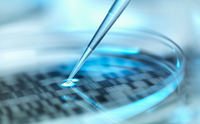








Genetic fingerprinting, DNA testing and DNA profiling are techniques used to distinguish between individuals of the same species using only samples of their DNA. Its invention by Sir Alec Jeffreys at the University of Leicester was announced in 1985.
Two humans will have the vast majority of their DNA sequence in common. Genetic fingerprinting exploits highly variable repeating sequences called microsatellites. Two unrelated humans will be likely to have different numbers of microsatellites at a given locus. By using PCR to detect the number of repeats at several loci, it is possible to establish a match that is extremely unlikely to have arisen by coincidence.
Genetic fingerprinting is used in forensic science, to match suspects to samples of blood, hair, saliva or semen. It has also led to several exonerations of formerly convicted suspects. It is also used in such applications as studying populations of wild animals, paternity testing, identifying dead bodies, and establishing the province or composition of foods. It has also been used to generate hypotheses on the pattern of the human diaspora in prehistoric times.
Testing is subject to the legal code of the jurisdiction in which it is performed. Usually the testing is voluntary, but it can be made compulsory by such instruments as a search warrant or court order. Several jurisdictions have also begun to assemble databases containing DNA information of convicts. The United Kingdom currently has the most extensive DNA database in the world, with well over 2 million records as of 2005. The size of this database, and its rate of growth, is giving concern to civil liberties groups in the UK, where police have wide-ranging powers to take samples and retain them even in the event of acquittal.
DNA fingerprinting process:
DNA fingerprinting begins by extracting DNA from the cells in a sample of blood, saliva, semen, or other appropriate fluid or tissue. A common method is a buccal swab.
Next, restriction fragment length polymorphism (RFLP) analysis is performed by using a restriction enzyme to cut the DNA into fragments which are separated into bands during agarose gel electrophoresis. Next, the bands of DNA are transferred via a technique called Southern blotting from the agarose gel to a nylon membrane. This is treated with a radioactively-labelled DNA probe which binds to certain and specific DNA sequences on the membrane. The excess DNA probe is washed off. An X-ray film placed next to the nylon membrane detects the radioactive pattern. This film is then developed to make a visible pattern of bands called DNA fingerprinting.
Recently, an additional technique for genetic fingerprinting has been introduced: AFLP, or amplified fragment length polymorphism. This new technique is similar to RFLP analysis, but introduces a few other features, like two rounds of amplification and specially made primers. AFLP analysis is now highly automated, and allows for easy creation of phylogenetic trees based on comparing individual samples of DNA.
One of the most modern and widely accepted methods for producing DNA fingerprints in criminal cases, is that of polymerase chain reaction (PCR). PCR involves the amplification of specific regions of DNA that are known to be highly variable from one individual to another. This amplification process allows the scientist to start with a very small amount of material, and the outcome is a highly discriminating outcome, with the chance of a random match being in the 1 in a billion region. PCR is by far the most common method for presenting DNA evidence in a forensic context.
Considerations when evaluating DNA evidence
In the early days of the use of genetic fingerprinting as criminal evidence, juries were often swayed by spurious statistical arguments by defence lawyers along these lines: given a match that had a 1 in 5 million probability of occurring by chance, the lawyer would argue that this meant that in a country of say 60 million people there were 12 people who would also match the profile. This was then translated to a 1 in 12 chance of the suspect being the guilty one. This argument is not sound unless the suspect was drawn at random from the population of the country. In fact, a jury should consider how likely it is that an individual matching the genetic profile would also have been a suspect in the case for other reasons. The false assumption that a 1 in 5 million probability of a match automatically translates into a 1 in 5 million probability of innocence is known as the prosecutor's fallacy.
Nowadays, more testing is carried out so that the theoretical risk of a coincidental match is 1 in 100 billion (100,000,000,000). However, the rate of laboratory error may be much higher than this, and often actual laboratory procedures do not reflect the theory under which the coincidence probabilities were computed. For example, the coincidence probabilities may be calculated based on the probabilities that markers in two samples have bands in precisely the same location, but a laboratory worker may conclude that similar -- but not precisely identical -- band patterns result from identical genetic samples with some imperfection in the agarose gel. However, in this case, the laboratory worker increases the coincidence risk by expanding the criteria for declaring a match.